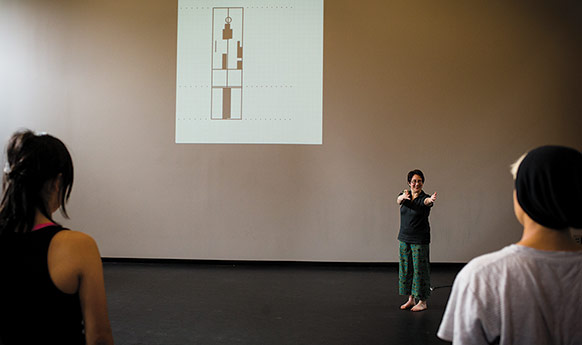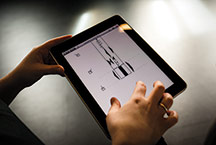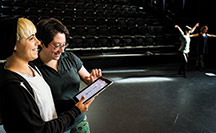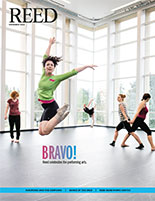
IRIS login | Reed College home Volume 92, No. 4: December 2013
Dance of the Pixel

Photos by Leah Nash
Reed prof leaps into terpsichorean technology, iPad in hand.
By Romel Hernandez
Like a frolicsome sprite capering through an enchanted forest, the dancer stands on her toes, spins a pirouette, soars through the air with an impressive leap and—oh, wait a second.
A few taps on an iPad rewrite and rearrange an intricate sequence of shapes, symbols, and squiggles on screen, indicating how the dancer’s body should move through space and time. Turn right, not left. Point the arm like this. Make it three grands jetés.
Invented almost 100 years ago, Labanotation (also known as Laban movement notation) is a language for writing the choreographic equivalent of a musical score. Put the right symbols together, and you might have a ballet choreographed by George Balanchine or a dance piece by Martha Graham, a Scottish Highland fling or the electric slide.
Hannah Kosstrin, visiting assistant professor of dance, is bringing Labanotation into the digital age with a new iPad app named KineScribe.
“I just thought, ‘How cool would it be to bring the iPad into the dance studio?’” Prof. Kosstrin says. “Creating this app can make dance notation more accessible in a way that is engaging and user-friendly.”
Funding for the initial work on KineScribe was provided by Reed’s iPad program for faculty, which supports professors who want to bring new technology into the classroom, furthered by additional support from Marty Ringle, Reed’s chief information officer, and buttressed by a $25,000 grant from the National Endowment for the Humanities. After last-minute testing and tweaking over the fall, KineScribe is now available to dancers everywhere—at no cost—through the App Store.
With so many students bringing tablets and laptops to the classroom, more professors are discovering creative ways to use the technology to engage and enhance student learning, says Trina Marmarelli, Reed’s director of instructional technology services. Some professors are happy to stick with blackboards and chalk, but the college also wants to support faculty willing to experiment with new approaches. The KineScribe project is a sterling example of how professors can integrate technology into their teaching.
“[KineScribe] has such immediacy—there’s almost a sensory connection with the app,” Marmarelli says. “An iPad is so portable, the user can be there right alongside the dancer or the choreographer during a rehearsal or performance.”
Kosstrin started dance classes at age four and continued through high school, studying a variety of dance forms and composition at local dance studios and a summer arts program in the Boston area. She attended Goucher College in Maryland, planning to become a dance teacher. Inspired by an overseas program to study dance in London, she shifted her focus from dance education to history.
She went on to study dance at the Ohio State University, and also enjoyed time performing with and running a small dance organization between earning her MA and PhD degrees in dance history and dance studies. With her interests firmly entrenched in scholarship, Kosstrin had not performed on stage in years until last summer. As scholar in residence at the Bates Dance Festival, she performed in the annual faculty improvisational dance performance alongside prominent choreographers and dancers, an experience she found terrifying, then exhilarating.
“I’d always enjoyed performing, but I also knew performing was not the end for me,” she says. “There’s something so special about performing, about having this experience that is physical and emotional and intellectual all at the same time. There’s nothing like it.”
Kosstrin’s academic interests encompass dance, history, and culture, especially Jewish and gender studies. Since joining Reed in 2010, she has taught classes from introductory to advanced dance, as well as conferences, including “Jewish and Israeli Dance: Social and Concert Dance of Israel and the Jewish Diaspora” and “Queer Dances: Gender, Sexuality, and Identity in Modern and Contemporary Dance.” She is also at work on a book about Anna Sokolow, the influential American dancer and choreographer noted for her radical politics.
Enhancing Dance Literacy: iPad Usage in Class
Kosstrin also teaches a class in Labanotation, a subject she has pursued throughout her education. Rudolf Laban, a Hungarian dancer and teacher, first introduced his dance notation system in 1928. The system evolved and gained widespread currency until the emergence of film and video made it easier—and cheaper—to document dance performances.
Kosstrin contends, however, that “what dance notation does that video can’t do is to get you inside the work so you can understand what is going on. Think of it as the difference between reading a musical score or listening to a recording—it’s just not the same.”
To create the app, she reached out to a programmer from Ohio State who had worked on an established software program called LabanWriter. Serendipitously, she discovered the programmer, David Ralley, was working for a tech company and living in Portland. The pair agreed to collaborate on the project, with Kosstrin providing dance expertise and Ralley writing the code.
“It’s been a great partnership,” says Ralley, who notes he is not a dancer. “I can’t say enough about Hannah’s energy and her creative input. She has very specific ideas about functionality, so we just try things out and see if they work; if they don’t, we try something else.”
Along the way, Kosstrin worked with the Dance Notation Bureau in New York and the extension office at OSU and received approval by senior notators Lucy Venable and Ann Hutchinson Guest to use the notation symbols in the app.
“Hannah was really the vision and the driving force,” Marmarelli says. “I have just been so impressed with the incredible amount of energy and time she has put into this project on top of her teaching and research.”
Throughout the development of various beta versions, Kosstrin has made sure to test KineScribe with the generation she hopes will eventually embrace Labanotation—her students.



LATEST COMMENTS
steve-jobs-1976 I knew Steve Jobs when he was on the second floor of Quincy. (Fall...
Utnapishtim - 2 weeks ago
Prof. Mason Drukman [political science 1964–70] This is gold, pure gold. God bless, Prof. Drukman.
puredog - 1 month ago
virginia-davis-1965 Such a good friend & compatriot in the day of Satyricon...
czarchasm - 4 months ago
John Peara Baba 1990 John died of a broken heart from losing his mom and then his...
kodachrome - 7 months ago
Carol Sawyer 1962 Who wrote this obit? I'm writing something about Carol Sawyer...
MsLaurie Pepper - 8 months ago
William W. Wissman MAT 1969 ...and THREE sisters. Sabra, the oldest, Mary, the middle, and...
riclf - 10 months ago